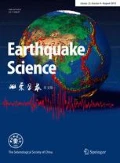Abstract
Based on 294 earthquake sequences with magnitude greater than or equal to 5.0 occurred in Chinese mainland since 1970, the spatial distribution features of sequence types have been studied. In southwestern China, it takes mainshock-aftershock sequence type (MAT) as the major in Chuan-Dian rhombic block and concerned Xianshuihe-Anninghe-Xiaojiang seismic belt, as well as in Jinshajiang-Honghe seismic belt. Multiple mainshock type (MMT) mainly distributes in western Yunnan, and Longlin and Lancang areas in Tengchong-Baoshan block in west of Nujiang-Lancangjiang fault zone. A few isolated earthquake type (IET) mainly occurred in northwestern Sichuan and there is no IET occurred in Yunnan region. In northwestern China, it takes mainshock-aftershock sequence type (MAT) as the major in west segment of South Tianshan in Xinjiang region. Some MMT also occurred in this area in the intersection of Kalpin block and the Puchang fault zone. It takes IET as the major in middle Tianshan in Xinjiang. Along the Qilianshan seismic belt, most of sequences are MAT. In Qinghai region, it takes MAT as the major, but the regional feature of the spatial distribution of sequence types is not very clear. In North China, it takes MAT as the major in Yinshan-Yanshan-Bohai seismic belt, north edge of North China, and in Hebei plain seismic belt, as well as in sub-plate of lower river area of Yangtze River. In intersection of north segment of Shanxi seismic belt and the NW-trending Yinshan-Yanshan-Bohai seismic belt, there are several moderate or strong MMT with magnitude from 5.0 to 6.0 occurred. In south of North China around the latitude line of 35°N, it takes IET as the major. The spatial distribution of sequence types is relevant to the patterns of tectonic movements. MAT is mostly produced by the ruptures of locked units or asperities or the neonatal separating segments inside the fault zones. MMT is generally relevant to the conjugate structures or intersection of many tectonic settings. Further extension of simple fault often produces IET. Spatial distribution of sequence types is also correlative to the regional and deep environment of crustal medium to some extent. MAT mainly distributes in high velocity area in upper crust or in the transition zone between high velocity area and low velocity area, MMT mostly occurred in the low velocity area in upper crust.
Similar content being viewed by others
References
CHEN Pei-san, LIU Fu-tian, LI Qiang, et al. 1990. Lateral heterogeneity of velocity structure in Yunnan region [J]. Science in China (Series B), 20(4): 431–438 (in Chinese).
FU Shu-fang and LIU Bao-cheng. 1991. Schoolbook of Seismology (version 2) [M]. Beijing: Seismological Press, 578 (in Chinese).
FU Zheng-xiang. 1982. Duration of the sequence of strong aftershocks of a major earthquake [J]. Acta Seismologica Sinica, 4(4): 389–394 (in Chinese).
GUO Da-qing, LIU Pu-xiong, YUAN Yi-fan, et al. 1998. Brief and Technique Guideline on Earthquake Process [M]. Beijing, Seismological Press, 25–26 (in Chinese).
GUO Shun-min, XU Xi-wei, XIANG Hong-fa, et al. 2002. Segmentation of earthquake rupture and earthquake prediction along the Longling-Lancang fault zone in the southwestern Yunnan Province [J]. Seismology and Geology, 24(2): 103–114 (in Chinese).
Kisslinger C. 1996. Aftershock and fault-zone properties [J]. Advances in Geophysics, 38: 1–36.
LIU Jian-hua, LIU Fu-tian, WU Hua, et al. 1989. 3-D velocity images of crust and upper mantle in South-North zone in Chinese mainland [J]. Chinese J Geophys, 32(2): 143–151 (in Chinese).
LIU Pu-xiong, CHEN Xiu-qi, LU Xiao-jian, et al. 1996. Research prediction of following noticeable shocks of earthquake sequences [J]. Acta Seismologca Sinica, 9(1): 33–40.
Mogi K. 1963. Some discussions on aftershocks, foreshocks and earthquake swarms-the fracture of a semi-infinite body caused by inner stress origin and its relation to the earthquake phenomena (3) [J]. Bull Earthquake Res Inst Univ Tokyo, 41: 615–658.
Reasenberg P. 1999. Foreshock occurrence before large earthquakes [J]: J Geophys Res, 104(B3): 4 755–4 768.
Richter C F. 1958. Elementary Seismology [M]. San Francisco: Freeman, 768.
SU You-jin, LIU Zu-yin, CAI Min-jun, et al. 1999. Deep medium environment of strong earthquakes occurrence in Yunnan region [J]. Acta Seismologca Sinica, 12(3): 345–356.
SU You-jin and QIN Jia-zheng. 2001. Strong earthquake activity and relation to regional neotectonic movement in Sichuan-Yunnan region [J]. Earthquake Research in China, 17(1): 24–34 (in Chinese).
Utsu T. 2002. Statistical Features of Seismicity [A]. In: Lee W H K, Kanamori H, Jennings P, et al ed. International Handbook of Earthquake and Engineering Seismology, 81A [C]. Amsterdam: Academic Press, 719–731.
WU Kai-tong, JIAO Yuan-bi, LU Pei-ling, et al. 1990. Panorama of Earthquake Sequences [M]. Beijing: Peking University Press, 97–114 (in Chinese).
XU Zhong-huai. 2001. A present-day tectonic stress map for eastern Asia region [J]. Acta Seismologica Sinica, 14(5): 524–533.
ZHOU Hui-lan, FANG Gui-rong, ZHANG Ai-di, et al. 1980. Discussion on the judgment of sequence types [J]. Northwestern Seismological Journal, 2(2): 45–59 (in Chinese).
ZHOU Hui-lan, FANG Gui-rong, ZHANG Ai-di, et al. 1982. Duration of aftershock sequences [J]. Acta Seismologica Sinica, 4(1): 45–54 (in Chinese).
Author information
Authors and Affiliations
Corresponding author
Additional information
Foundation item: Joint Seismological Science Foundation of China (105076) and continued subject “Statistic Features of Aftershock Sequences and Forecast of the Large Aftershocks” (2004BA601B01-04-02), Ministry of Science and Technology of China in the 10th Five-Year Plan.
About this article
Cite this article
Jiang, Hk., Li, Yl., Qu, Yj. et al. Spatial distribution features of sequence types of moderate and strong earthquake in Chinese mainland. Acta Seimol. Sin. 19, 417–427 (2006). https://doi.org/10.1007/s11589-004-0417-5
Received:
Accepted:
Issue Date:
DOI: https://doi.org/10.1007/s11589-004-0417-5
Key words
- spatial distribution of sequence types
- isolated earthquake
- mainshock-aftershock sequence
- multiple mainshock type
- patterns of tectonic movement
- medium environment in depth of the earth



